The Gift of South Dakota
Subscriptions to South Dakota Magazine make great gifts!
Subscribe today — 1 year (6 issues) is just $29!
Will We Change?
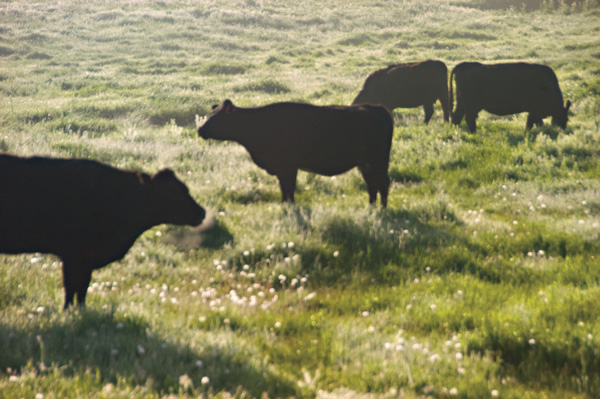 |
Editor’s Note: This story is revised from the July/August 2009 issue of South Dakota Magazine. To order a copy or to subscribe, call (800) 456-5117.
At first glance it may appear that South Dakota stock growers are divided into factions — producers of conventional, natural, organic and even organic kosher beef. But in talking to cattle producers around the state, you find they’re unfailingly respectful of one another.
Their uniform message seems to be: select any form of meat you like as long as it’s beef (preferably American grown, they add).
These producers are respectful, too, of people asking questions. Like, why is organic beef taking so long to establish itself, especially since we’ve began hearing about it in the 1980s?
“Compared to organic dairy and poultry, you don’t have a quick turnover,” says Charlie Johnson of rural Madison, an organic farmer in business with his brother, Allan. “Beef is a once-a-year product.”
What’s more, says Dakota Beef plant manager Larry Holtrop in Howard, it takes a while to get set up for raising organic livestock. Land has to be free of chemical fertilizers, herbicides and pesticides for three years. “Then you certify that every step of the animal’s progress has been free of chemical compounds,” Holtrop explains. “And you don’t just send the USDA an application and fifty bucks. They come out and check.”
There’s more. While South Dakota is known everywhere as great cattle country, and our stock growers are highly regarded for verification honesty, the state isn’t the best market for natural or organic meat. Organic products cost more. “The market levels are higher on both coasts,” says John Bruner, owner of Dakota Natural Beef north of Winfred. “These are products sought after by higher income groups.” And South Dakota wasn’t exactly first in line when it came to environmental, health-conscious thinking (stock growers often offer themselves as examples).
There are people everywhere (the coasts included) who categorize their steaks only as T-bones, ribeyes and sirloins, or currently trendy Angus versus everything else. So it’s good to look at definitions, still being written in some areas, as the USDA works to clarify the language and labeling.
To begin with, there’s “conventional” beef, which the world’s producers earnestly worked to improve during the 20th century. They put fertilizers and herbicides to use for lush grass and plentiful grains, and they employed antibiotics and hormones for animal health and growth. Then along came “natural” beef, which increasingly means verified to be antibiotic and hormone free over the animal’s lifetime — although in the past the term has meant anything from minimally processed to chemical free during the animal’s final weeks. The USDA is currently crafting tight defining language for “natural.” And there’s “organic” beef, taking the chemical-free concept several steps further, with verification strictly enforced by the USDA. Organic beef comes from livestock antibiotic and hormone free over its entire lifetime, born and raised on chemical-free lands, and fed only organic feeds.
“Organic regulations are so strict that inspectors will look into whether runoff from another pen could reach organic cattle,” Holtrop says. “Even what we use to clean our plant at Dakota Beef has to be organic.”
Not only cattle, but everything else that can be grown on a farm or ranch has been touched in some way by the organic movement. One of the first hints of that movement could be seen on the Bernie Johnson farm in the late 1960s. Charlie and Allan Johnson’s dad “was a hippie with a crew cut,” Charlie recalls. “His philosophy was he didn’t want anything on his farm that he couldn’t put on the tip of his tongue. Not many people were thinking like that then. But if 100 people came to a fork in the road, and 99 went one way, he’d go the other. It turned out he was prophetic.”
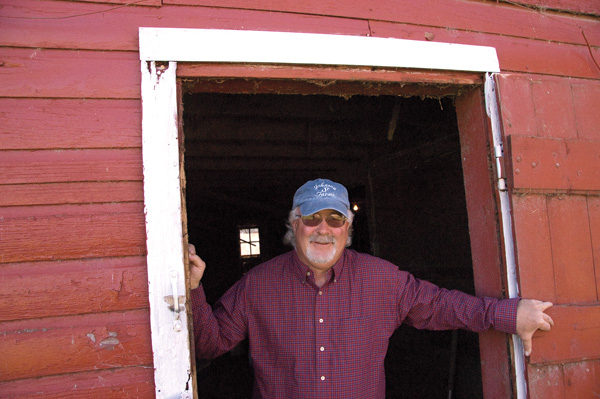 |
| Charlie Johnson (above) and his brother, Allan, grew up on a chemical-free Lake County Farm, the sons of "a hippie with a crew cut" whose farming practices proved prophetic. |
And willing to take action. By the mid-1970s, about the time Charlie graduated from high school, the few acres Bernie kept chemical free in the 1960s had expanded to encompass the entire farm. “So it’s all I’ve ever known, really,” Charlie says. “We’re pretty good stewards of the land here. Being organic keeps the soil qualities high. We rotate alfalfa, soybeans, corn, soybeans again, and the oats sown with alfalfa.”
Still, with some organic grains selling for human food products at twice the price of conventional grains, “I can’t afford to run them through my cows,” he says. Charlie and Allan run 180 head of Angus and Gelbvieh cross cattle, which consume roughage and provide organic fertilizer. But calves are mostly sold as feeder cattle, not finished off as certified organic beef.
It’s not only the high value of organic grain as human food that comes into play. Limited availability of those grains at times has kept some stock growers from thinking about finishing off organic beef. A few years ago, finished agricultural products were what state government said it hoped South Dakotans would produce; “value added” was the term. In that climate John Bruner established Dakota Natural Beef and found he could finish antibiotic-free and hormone-free beef that was consistently good. “We can get into a market because our product is natural, but we can stay in it only if we provide a high quality eating experience week after week,” Bruner says. “I can do that with natural beef, but I might not be as consistent if I were organic, because quality isn’t only taste but also tenderness.”
He explained that plenty of diners like grass fed beef. But August grass isn’t June grass. That’s where the tenderness Bruner demands in his beef becomes tricky. “Tenderness in beef comes about because of a rapid production of protein in the animal,” Bruner explains. “That happens when cattle eat green grass in early summer. But protein gains slow down by late summer if you don’t add supplements, when the grass is dry and hard.”
As talk about the lucrative markets for organic beef grew 10 years ago, observers looked at the challenges South Dakota stock growers faced and said it would take deep pockets to launch large-scale production here. Someone would have to devise a formula to cover the costs of those grains, develop feedlots, understand the emerging national market — plus find a community open to a new packing plant. Integrating an organic component into an existing conventional beef processing plant is extremely difficult because of possible contamination issues.
Then in 2004, Howard welcomed Scott Lively to the state as he was searching for a home for an organic beef company. Dave Clarke had a building, just off Highway 34, that could be modified and expanded to serve as a state of the art processing plant. Things came together so quickly that in 2005 the Wall Street Journal featured Howard and Lively’s fledgling Dakota Beef Company plus the town’s commitment to wind energy on page one. Dakota Beef could be found nationwide, from high-end restaurants pleased to offer customers organic steaks, to major league ballparks serving fans organic all-beef hot dogs.
In 2006 father and son David and Daniel Feinberg stepped in as Dakota Beef lending investors. After Lively left the company in March, the Feinbergs became exclusive owners. With investment and real estate backgrounds, and offices on the 32nd floor of a New York City office tower, now they’re getting to know rural South Dakota (not that much of a stretch, they stress, because of other business dealings in Colorado and a 150,000 acre working ranch David owns in Oregon). The Feinbergs have come to appreciate South Dakota’s “welcoming attitude and honesty,” said Daniel.
“South Dakota has some of the highest quality cattle anywhere.” David Feinberg says. “But it’s seldom organic.”
So Dakota Beef trucks organic cattle to Howard from all over. It processes close to 100 per week at the busiest times, and maybe 40 to 80 when demand dips. The owners see opportunities for growth long term, and for South Dakota stock growers immediately. “If there are South Dakotans we don’t know who are finishing organic beef, we’d like to work with them,” Daniel said.
A few years back, the Feinbergs guessed organic beef’s future would be bright. “But our interest initially was a health one,” David says.
By no means do all organic beef producers and processors say that. A good number admit to feeling more comfortable discussing their product in terms of supply and demand — if customers feel better about eating organic, those entrepreneurs are happy to supply it, no questions about buyer motivations asked.
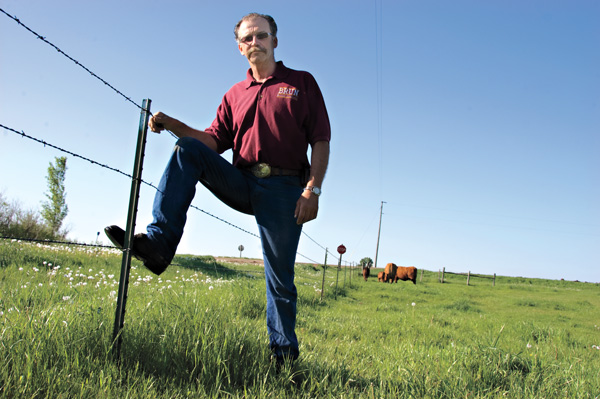 |
| South Dakota has a reputation for great beef thanks to cattlemen like John Bruner, but the best markets for organic products are far from his Winfred ranch. |
The Feinbergs, though, have studied the work of Dr. Andrew Weil, suggesting that hormones passed from cows into dairy products can carry cancer risks, especially for women. If that’s the case, they feel, the same dangerous hormones might be found in conventional beef. “There’s also some thinking that antibiotics found in foods can limit the performance of antibiotics when they’re used for humans,” said Daniel. It surprises him that some consumers worry they might expose themselves to pesticides if they don’t carefully wash their apples, but don’t consider how cattle can carry pesticides if pastures aren’t chemical-free.
Health consciousness will always be a driving force behind organic sales, but there’s another emerging trend that has the Feinbergs projecting growth for their Howard plant. That’s the kosher market. Currently 10 to 15 percent of their product is doubly certified, as organic and as kosher. Kosher means the animal is downed with a precise neck cut in accordance with Old Testament law. While the Jewish market is key to kosher sales, Daniel said, the reason those sales are growing is because other people are committing to kosher “for spiritual and animal welfare reasons.” A solid argument can be made that a proper neck cut with a very sharp knife results in less animal distress than conventional slaughter. Glatt kosher means the animal was found to be in outstanding health prior to the kill, which is important to buyers seeking additional safety assurances.
The city of Howard is optimistic enough about Dakota Beef’s growth that it is studying municipal infrastructure improvements that may be required if a larger plant is necessary.
“Because of the process and costs, it’s expensive to run an operation like this on a small scale,” Holtrop says. With four decades of meat packing plant management on his resume, Holtrop was drawn to Dakota Beef in March “because this is a world-class challenge. There’s a big market out there for this product if we do things right.”
If the process and costs make organic beef a challenge for a packing plant, the same is true for stock growers. Dakota Beef’s Dr. Evan Whitley, who heads the company’s livestock division, can help producers get started.
So can Jim Krantz. An extension educator through South Dakota State University, Krantz has an office in the Miner County courthouse, just blocks from Dakota Beef. He first makes certain stock growers understand USDA requirements, “and we sort through any confusion about what natural is, and what organic is.”
A health program for both cow and calf is extremely important, Krantz stresses, “and producers considering this should know that even organic cattle can have vaccines. The other thing we always work on is nutrition, a way of regulating intake and the consistency of the intake. We develop a ration program.” Part of the program, Krantz adds, could include feeds that some stock growers haven’t previously considered, such as flax and barley.
So there’s no doubt some South Dakota cattle will experience altered diets in coming years. There’s no doubt that Americans coast to coast will enjoy new types of South Dakota beef, although in what quantity remains to be seen. Maybe these are the most important questions. Will South Dakotans feel inclined to spend a bit more to alter their diets? And will the rest of America follow our example?



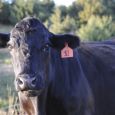

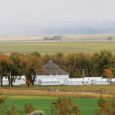
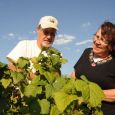



Comments